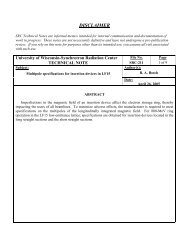SRC Users' Meeting - Synchrotron Radiation Center - University of ...
SRC Users' Meeting - Synchrotron Radiation Center - University of ...
SRC Users' Meeting - Synchrotron Radiation Center - University of ...
Create successful ePaper yourself
Turn your PDF publications into a flip-book with our unique Google optimized e-Paper software.
calculated binding energies <strong>of</strong> the quantum well states to the observed values. The calculated<br />
binding energies <strong>of</strong> the quantum well state from the fit are shown as open circles connected by<br />
lines in Fig. 2, and the quantum number n for each branch is indicated. The results agree well<br />
with the experimental values shown as crosses. The experimental value for the quantum well<br />
state at N = 11 is not included in the figure because the peak is too close to the Fermi level for a<br />
precise determination <strong>of</strong> its position.<br />
The confinement edge at 0.5 eV is indicated by a horizontal dashed line in Fig. 2. In<br />
agreement with experimental observations, no quantum well states exist, or only weak<br />
resonances are observed, for even N = 4, 6, 8, and 10, while intense quantum-well states are<br />
observed for odd N = 5, 7, and 9. This difference between even- and odd-N configurations is just<br />
a consequence <strong>of</strong> the way that the quantum well states evolve as a function <strong>of</strong> thickness as seen<br />
in Fig. 2. This evolution is largely determined by the band structure [3, 5, 8, 9]. It happens that<br />
one half <strong>of</strong> the Fermi wave length in Pb is approximately two atomic layers, and a simple<br />
analysis based on Eq. (1) shows that a new quantum well state drops below the Fermi level for a<br />
film thickness increment <strong>of</strong> about two atomic layers [3, 5]. The corresponding changes in the<br />
occupied density <strong>of</strong> states should give rise to an oscillation period <strong>of</strong> about two atomic layers for<br />
essentially all physical properties <strong>of</strong> the films. Also in agreement with our experimental<br />
observation is that no quantum well states are predicted for N = 1-3.<br />
Numerous groups have experimented with Pb growth on Si [8-13], but none has achieved<br />
atomic uniformity. Prior to this experiment, we had performed extensive experimentation with<br />
direct deposition on the (7x7) reconstructed Si(111) at various temperatures, but the resulting<br />
films were inevitably rough. In the present experiment, the atomic-layer uniformity is achieved<br />
by first preparing either the or 3 3<br />
reconstructions [12, 14, 15]. Our experiment<br />
shows that deposition <strong>of</strong> Pb on the phase, the phase, or any intermediate phases at a low<br />
temperature (100 K) leads to atomically uniform films. The final results are the same for the<br />
same total amounts <strong>of</strong> Pb deposition including the initial Pb coverages. The determination <strong>of</strong><br />
film thicknesses is described in detail in [1].<br />
The stability <strong>of</strong> the films has been measured, and some interesting features were<br />
observed, including the bilayer oscillation predicted by Wei et al. [17].<br />
Why does Pb pretreatment promote uniform film formation, while direct deposition on<br />
Si(111)-(7x7) does not work? A possible explanation is that the (7x7) surface, with its<br />
complicated reconstruction involving adatoms, dimers, corner holes, and partial stacking fault, is<br />
not smooth on the atomic scale. These structural features can pin the Pb growth locally at low<br />
temperatures, resulting in small crystallites that are structurally incoherent. Increasing the<br />
substrate temperature to promote long-range diffusion and structural coherence leads to<br />
formation <strong>of</strong> islands instead <strong>of</strong> smooth films due to electronic effects [10, 16]. Pretreatment <strong>of</strong> Si<br />
by Pb leads to a smooth bulk-terminated Si substrate with a well ordered Pb overlayer. This can<br />
be a good template for smooth growth upon further deposition at low temperatures. Our results<br />
illustrate an important issue in film growth – the initial surface structure can be a deciding factor<br />
for the morphological development <strong>of</strong> films. As shown in this study, proper conditioning <strong>of</strong> the<br />
starting surface allows us to make uniform films on Si, a result <strong>of</strong> potential interest and<br />
importance for nano and quantum electronics.<br />
This work is supported by the U.S. National Science Foundation (grant DMR-02-03003).<br />
We acknowledge the Petroleum Research Fund, administered by the American Chemical<br />
Society, and the U.S. Department <strong>of</strong> Energy, Division <strong>of</strong> Materials Sciences (grant DEFG02-<br />
91ER45439), for partial support <strong>of</strong> the synchrotron beamline operation and the central facilities
















